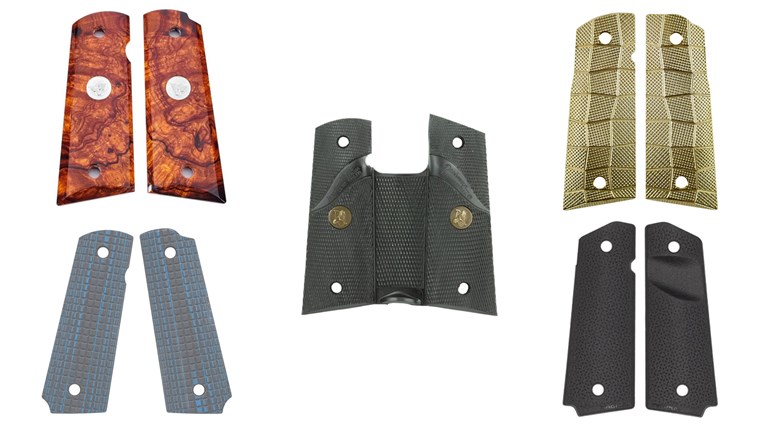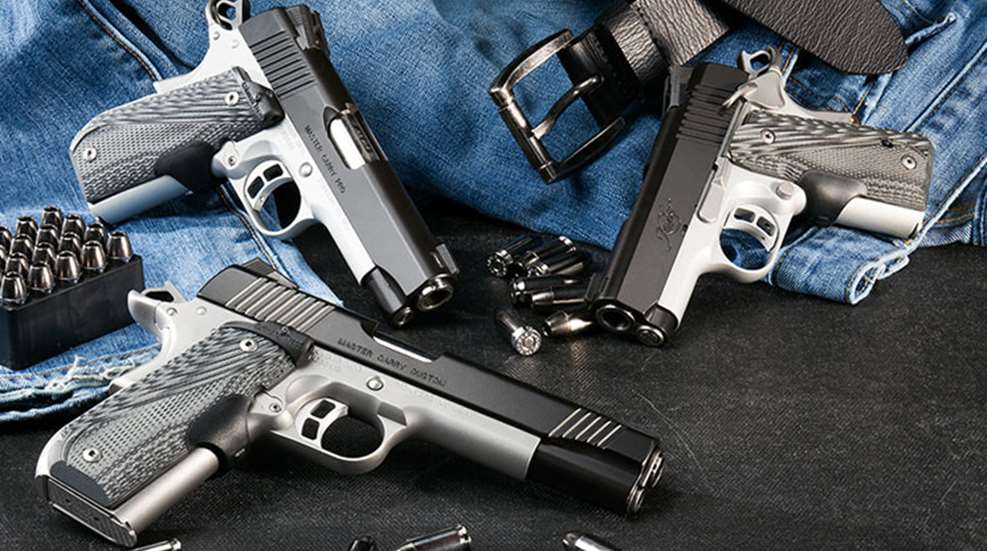
Most problems have a single best solution, although the solution may not be the same for all individuals. When confronted by a multitude of various problems, selecting the best solution will likely involve a number of trade-offs and compromises. This can result in a solution that isn’t optimum for any one of the problems, but works reasonably well for them all. In the world of handguns suitable for self-defensive, Kimber seems to have an excellent grasp of this concept.
To begin with, Kimber’s best-known firearm platform is the Model 1911, considered by knowledgeable pistoleros to be the finest fighting handgun ever designed. The company also recognizes not all users are the same, nor will they all be dealing with the same scenarios. The result is when Kimber manufactures a 1911 solution the company thinks is practical and will help keep users safe, it offers a series of those pistols for the user to evaluate so the consumer can select the most useful option for his or her needs.
Case in point, the Kimber Master Carry Series, all chambered in .45 ACP, the caliber designed to stop bad behavior quickly and authoritatiwvely. While some features vary on the three differently sized pistols, most of the key capabilities and components are the same on all of them.
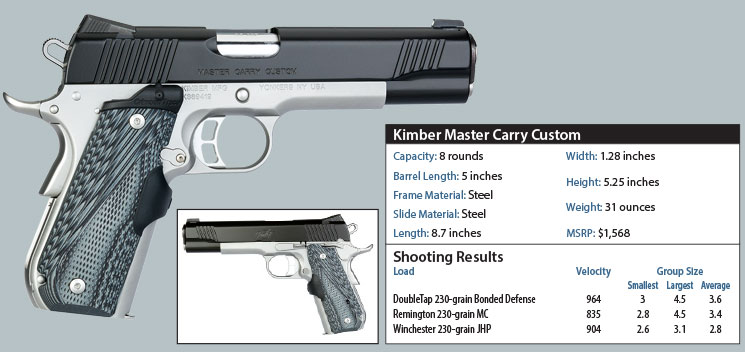
Starting with the largest and working down, Kimber offers the Master Carry Custom with a 5-inch barrel and slide, the Master Carry Pro with a 4-inch barrel and slide and the compact Master Carry Ultra with a 3-inch barrel and slide. Weight decreases by 3 ounces for each inch of barrel lost, going from 31 ounces for the Custom down to 25 ounces for the Ultra. The Custom and Pro models are the same height at 5.25 inches, while the Ultra’s grip frame has been shortened, shaving half an inch from its total height and reducing the magazine capacity from eight to seven rounds.
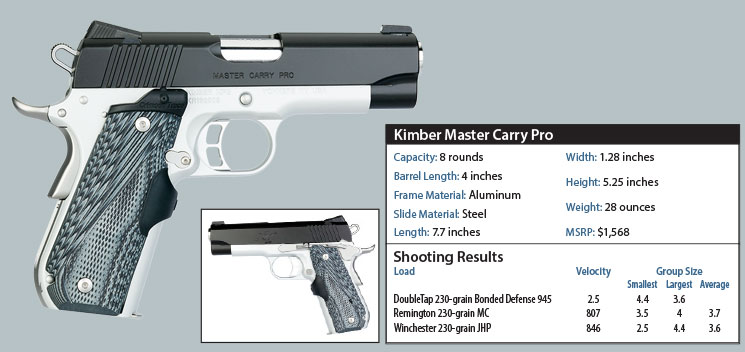
The recoil springs have different tension weights: 18 pounds in the Custom, 22 pounds in the Pro and 16 pounds in the Ultra. Having spent much of my time recently with 9 mm and .380 ACP pistols, the springs initially felt heavier than I remembered, but the serrations at the rear of the slide on each gun provided ample purchase to manually operate the slide and perform chamber checks. However, only the longer Custom had serrations near the front of the slide, so if your chamber check technique involves pulling rearward from the front or if you have any physical or medical limitations, make sure you can comfortably operate the smaller pistols before you commit. It is my experience that if you’re able to control a firearm chambered in .45 ACP, you’ll be able to operate any of the Master Carry family of pistols.
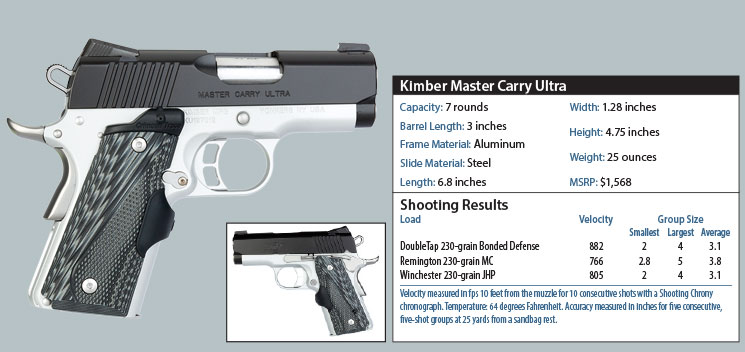
While all three guns look the same, only the larger Custom has both a stainless steel slide and frame. The two smaller models retain the stainless steel slide, but have aluminum frames. Frames on all three pistols have a satin-silver finish, while the slides wear a matte black KimPro II finish. All guns have aluminum match-grade triggers factory set between 4 and 5 pounds. Likewise, all three pistols have match-grade steel barrels with a 1:16-inch left-hand twist.
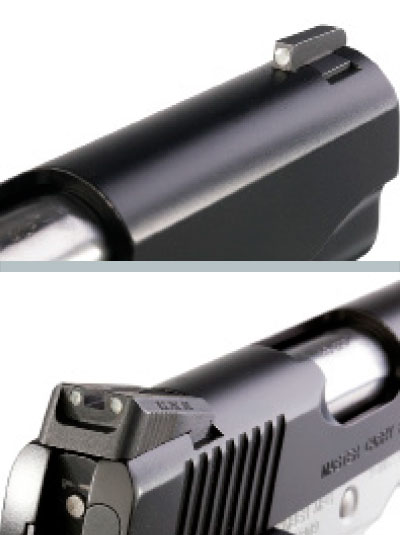
Sights are identical on all three models—Tactical Wedge Night Sights. They’re low-profile, dovetail-mounted and highly visible in either daylight or darkness. I prefer extremely conspicuous sights you can see at night, but which also allow precision shots in daylight. I kept the Master Carry Ultra on top of the vault next to my nightstand, and whenever I arose during the night, the Kimber’s location was immediately visible (and reassuring) thanks to the night sights. If you have trouble using your sights, don’t worry: each pistol has a set of Crimson Trace Lasergrips with the on/off switch discreetly placed in the left hand grip panel.
Finally, all three handguns have the round-heel frame with a serrated mainspring housing. The rounded heel looks different on the Ultra, since its grip frame is a half-inch shorter, but the contour is consistent as far as the frame extends and the intended function of enhanced concealment is fulfilled. I’ve become a fan of rounded mainspring housings on 1911s. Not only does it reduce the possibility of the gun printing or grabbing a cover garment on the point of the housing, I can also press the meat of my palm harder against the mainspring housing. This enables the web of my hand to put more pressure on the grip safety, ensuring its deactivation. This isn’t an idle concern for me—I’ve failed to depress the grip safety on a couple of 1911s in the past, resulting in much fumbling with my grip after presentation. It’s a small problem in training, but a potential catastrophe in a life-threatening situation.
Generally, lengthening the sight radius (and barrel) of a pistol will produce smaller groups and increase muzzle velocity at the rate of roughly 50 fps per inch of barrel. The Kimbers were pretty close to this standard on velocity readings, with incremental increases of 20 to 60 fps using typical 230-grain loads as barrel length increased. Accuracy-wise, the rule seemed to be true when going from the Ultra’s 3-inch barrel up to the Pro’s 4-inch pipe, but for me the difference wasn’t enough to cause concern. An increase in group size of .5 to 1 inch at 25 yards is irrelevant for a self-defense firearm. To put it another way, ease of concealment and carry comfort outweigh that small change in group size. In stepping up to the Custom’s 5 inch barrel, there was no significant improvement in accuracy at 25 yards. This was something I learned years ago, when I selected a 4-inch-barreled 1911 as the primary pistol on my California CCW license. Push the ranges out beyond 25 yards and both sights and sight radius selection might change, but any imminent threat to my life originating at longer ranges would probably not be best solved by engaging in a pistol duel.
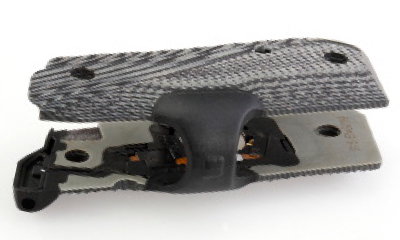
The most noticeable difference I felt in shooting the Master Carry series had to do with the grips. Obviously, the grips must be larger since the Crimson Trace laser housing sits atop the right hand grip panel, adjacent to the bottom of the slide. You don’t feel the housing because it’s not part of the panel where you grip. You also don’t see or notice the housing, because it’s more than an inch away from your line of sight. The activation switch, however, is a different matter. It’s located in a rather thick piece of rubber that circles the frontstrap, connecting the two grip panels just below the trigger guard. The rubber strip runs beneath the middle finger of your shooting hand, which is one of your two primary gripping fingers.
When pointing the Kimber at the target, your normal shooting grip will cause your middle finger to activate the laser—no additional thought or hand movement is required that might distract your attention from the threat. The downside is your 1911 feels larger than it did in the past. If you have small hands and were barely able to control a 1911 with smaller grip panels during rapid fire drills, you might have some control problems, particularly with the Ultra’s short barrel and slide. One of the reasons I’ve always liked the 1911 is it’s a good fit for my stubby-fingered hands. While I could feel the difference with the Crimson Trace switch pad on the frontstrap, it was not a concern in terms of control, even with the smaller, lighter Ultra. When not sleeping, I carried the Ultra concealed under a sweatshirt or long-tailed shirt in a Galco Avenger belt holster for three weeks. The Avenger is an outside-the-waistband holster with a straight drop that offers instant access to the pistol and rides rather high, with about 1 to 2 inches of leather showing below the belt. I’m aware an IWB rig would eliminate anything showing below the belt, but I’m uncomfortable with IWBs, and nontuckable versions still require an outside garment for concealment. There were no cases of either the gun or holster being inadvertently revealed during the test period. I carried the Kimber Pro in a slightly longer Avenger holster, also with no noticeable repercussions.
Range sessions with the Kimbers were pleasant (what’s not to like about shooting a Kimber 1911?) and informative. As expected, the rounded mainspring housings proved to be more comfortable, particularly with the shorter grip frame on the Ultra. In an extended training class of more than two days, I’ve been rubbed raw by the sharp surface of mainspring housings on typical 1911s. The 3-ounce difference between the large Custom and mid-size Pro didn’t seem to make any difference—thanks to the full-size grip, both were relatively easy to hold and control for multiple strings of fire. The 25-ounce Ultra wasn’t much more difficult to control, because there was enough real estate on the grip for all fingers of both hands to participate in a good shooting grip, and the rounded heel was comfortable enough to sustain that grip through multiple magazines. Like most shortened 1911s, the smaller pistol can use the eight-round magazines of the larger models, but the larger mags will not fit flush with the grip frame.
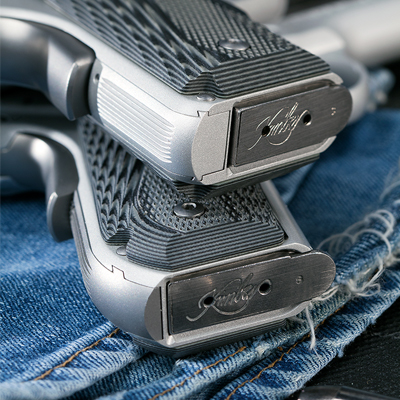
Magazine changes—even with the shorter seven-round versions—were clean and quick. Empty magazines dropped clear of the gun when the release button was pushed, and new mags inserted cleanly and locked in place. There was no interference of magazine movement or blockage of the magazine well by the heel of the shooting hand, despite the fact my hand extended past the base of the well. To further facilitate changes, the magazine wells on all three guns are slightly beveled in an understated, but highly adequate fashion. I don’t recall a 3-inch-barreled 1911 that operated as smoothly as the Ultra.
Reliability of all three guns on the range was 100 percent. It would have been interesting to chronograph the high-velocity, DoubleTap 160-grain loads to see what was lost in the two smaller pistols. Since this load produced the smallest groups in the 4-inch and 3-inch models and the highest velocity in the 5-inch version, it seems safe to say it would be an excellent defensive load in any of the Kimbers. I’m also curious as to how the heavy DoubleTap 255-grain Equalizer would feel in the smaller Ultra. However, ammunition-supply limitations rendered such experiments impossible. Besides, those are tests best performed by the shooter after acquiring a concealed-carry pistol.
After spending some time with these new Kimbers, I can safely say all three Master Carry models are superbly suited for self-defense. Of course, you must review your requirements to determine which pistol best meets your needs. If you plan to do a lot of shooting or training, size and weight are good things to have in a pistol. If your lifestyle and dress code don’t allow you to carry something full size, think smaller. All three Kimbers are comfortable to shoot—even with full-power loads—and all are capable of handling any threat you or your loved ones may happen to encounter.














